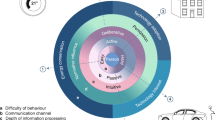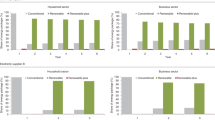Abstract
Subsidized energy assistance programmes are a popular policy tool for promoting energy justice, but, like other social benefits programmes, are often undersubscribed. To improve uptake, some programmes have turned to social influence strategies, such as asking programme participants to refer their peers. Here, through a field experiment with California’s low-income solar programme (N = 7,676), we show that referral behaviour depends on how existing participants are approached. Adding behavioural science strategies to a referral reward increases peer referral rates, referral quality and ultimately solar adoption. Compared with only reminding existing adopters of a potential US$200 reward for referrals that result in adoption, adding an appeal to reciprocity through a non-contingent US$1 gift—and further combining this gift with a simplified referral process—leads to 2.6–5.2 times as many solar contracts. These results highlight the potential of behaviourally informed peer referral programmes to accelerate equitable access to clean energy.
This is a preview of subscription content, access via your institution
Access options
Access Nature and 54 other Nature Portfolio journals
Get Nature+, our best-value online-access subscription
$29.99 / 30 days
cancel any time
Subscribe to this journal
Receive 12 digital issues and online access to articles
$119.00 per year
only $9.92 per issue
Buy this article
- Purchase on Springer Link
- Instant access to full article PDF
Prices may be subject to local taxes which are calculated during checkout



Similar content being viewed by others
Data availability
Exported data from the Salesforce database are not publicly available due to ethical and privacy concerns. An anonymized, public version of the dataset with referral behaviour and resulting solar contracts, without any personally identifiable information, is available on the Open Science Framework (https://osf.io/x4sqp/). The time-stamped data needed to generate Fig. 2c are proprietary to the non-profit partner. Zip-code-level data used in Supplementary Note 3 are not publicly available to protect the privacy of participants.
Code availability
Replication code to generate results from the anonymized, publicly available data is at https://osf.io/x4sqp/.
References
Carley, S. & Konisky, D. M. The justice and equity implications of the clean energy transition. Nat. Energy 5, 569–577 (2020).
Help to Heat Schemes. UK Government https://www.gov.uk/government/collections/find-energy-grants-for-you-home-help-to-heat (2023).
Inflation Reduction Act of 2022, Pub.L. No. 117–169. (Sec. 50122). https://www.congress.gov/bill/117th-congress/house-bill/5376 (2022).
Warmer Kiwi Homes programme. EECA https://www.eeca.govt.nz/co-funding/insulation-and-heater-grants/warmer-kiwi-homes-programme/ (accessed 30 March 2023).
Fully funded energy upgrades scheme. Sustainable Energy Authority of Ireland https://www.seai.ie/grants/home-energy-grants/fully-funded-upgrades-for-eligible-homes/ (accessed 27 March 2023).
Energy Conservation and Production Act, 42 U.S.C. §6863 - Weatherization Program. https://www.govinfo.gov/content/pkg/USCODE-2021-title42/html/USCODE-2021-title42-chap81-subchapIII-partA-sec6863.htm (2021).
Home Energy Support Program. ACT Government https://www.climatechoices.act.gov.au/policy-programs/home-energy-support-rebates-for-homeowners (2022).
New Green Savings Programme. State Environmental Fund of the Czech Republic https://www.sfzp.cz/en/administered-programmes/new-green-savings-programme/ (2023).
Rebate swap for solar. NSW Government https://www.energy.nsw.gov.au/households/rebates-grants-and-schemes/rebate-swap-solar (2023).
Currie, J. The Take Up of Social Benefits (Russell Sage Foundation, 2006).
Bhargava, S. & Manoli, D. Psychological frictions and the incomplete take-up of social benefits: evidence from an IRS field experiment. Am. Econ. Rev. 105, 3489–3529 (2015).
Finkelstein, A. & Notowidigdo, M. J. Take-up and targeting: experimental evidence from SNAP. Q. J. Econ. 134, 1505–1556 (2019).
Nonzee, N. J. et al. Delays in cancer care among low-income minorities despite access. J. Women’s Health 24, 506–514 (2015).
Remler, D. K. & Glied, S. A. What other programs can teach us: increasing participation in health insurance programs. Am. J. Public Health 93, 67–74 (2003).
Fowlie, M., Greenstone, M. & Wolfram, C. Are the non-monetary costs of energy efficiency investments large? Understanding low take-up of a free energy efficiency program. Am. Econ. Rev. 105, 201–204 (2015).
Reames, T. G. A community-based approach to low-income residential energy efficiency participation barriers. Local Environ. 21, 1449–1466 (2016).
Fox, N. Increasing solar entitlement and decreasing energy vulnerability in a low-income community by adopting the Prosuming Project. Nat. Energy 8, 74–83 (2023).
Rogers, E. M. Diffusion of Innovations 5th edn (Simon and Schuster, 2003).
Southwell, B. G., Slater, J. S., Nelson, C. L. & Rothman, A. J. Does it pay to pay people to share information? Using financial incentives to promote peer referral for mammography among the underinsured. Am. J. Health Promot 26, 348–351 (2012).
Gwadz, M. et al. Public health benefit of peer-referral strategies for detecting undiagnosed HIV infection among high-risk heterosexuals in New York City. J. Acquir. Immune Defic. Syndr. 74, 499–507 (2017).
Golden, M. R. et al. Peer referral for HIV case-finding among men who have sex with men. AIDS 20, 1961–1968 (2006).
Wolske, K. S., Gillingham, K. T. & Schultz, P. W. Peer influence on household energy behaviours. Nat. Energy 5, 202–212 (2020).
Bollinger, B. & Gillingham, K. Peer effects in the diffusion of solar photovoltaic panels. Mark. Sci. 31, 900–912 (2012).
Wolske, K. S. More alike than different: profiles of high-income and low-income rooftop solar adopters in the United States. Energy Res. Soc. Sci. 63, 101399 (2020).
Kraft-Todd, G. T., Bollinger, B., Gillingham, K., Lamp, S. & Rand, D. G. Credibility-enhancing displays promote the provision of non-normative public goods. Nature 563, 245–248 (2018).
Zanolini, A. et al. Feasibility and effectiveness of a peer referral incentive intervention to promote male circumcision uptake in Zambia. J. Acquir. Immune Defic. Syndr. 72, S262–S268 (2016).
Borenstein, S. It’s time for rooftop solar to compete with other renewables. Nat. Energy 7, 298–298 (2022).
O’Shaughnessy, E. Curbing rooftop solar is a poor way to promote equity. Nat. Energy 7, 299–299 (2022).
Barbose, G., Forrester, S., Darghouth, N. & Hoen, B. Income trends among U.S. residential rooftop solar adopters. US Department of Energy https://doi.org/10.2172/1603637 (2020).
Reames, T. G. Distributional disparities in residential rooftop solar potential and penetration in four cities in the United States. Energy Res. Soc. Sci. 69, 101612 (2020).
Lukanov, B. R. & Krieger, E. M. Distributed solar and environmental justice: exploring the demographic and socio-economic trends of residential PV adoption in California. Energy Policy 134, 110935 (2019).
Darghouth, N. R., O’Shaughnessy, E., Forrester, S. & Barbose, G. Characterizing local rooftop solar adoption inequity in the US. Environ. Res. Lett. 17, 034028 (2022).
Barbose, G., Forrester, S., O’Shaughnessy, E. & Darghouth, N. Residential solar-adopter income and demographic trends: 2021 update. Lawrence Berkeley National Laboratory https://escholarship.org/uc/item/473933mw (2021).
Sigrin, B. O. & Mooney, M. E. Rooftop solar technical potential for low-to-moderate income households in the United States. US Department of Energy https://doi.org/10.2172/1434891 (2018).
Sigrin, B., Sekar, A. & Tome, E. The solar influencer next door: predicting low income solar referrals and leads. Energy Res. Soc. Sci. 86, 102417 (2022).
Bergman, P., Lasky-Fink, J. & Rogers, T. Simplification and defaults affect adoption and impact of technology, but decision makers do not realize it. Organ. Behav. Hum. Decis. Process. 158, 66–79 (2019).
Beshears, J., Choi, J. J., Laibson, D. & Madrian, B. C. Simplification and saving. J. Econ. Behav. Organ. 95, 130–145 (2013).
Brandon, A., List, J. A., Metcalfe, R. D., Price, M. K. & Rundhammer, F. Testing for crowd out in social nudges: evidence from a natural field experiment in the market for electricity. Proc. Natl Acad. Sci. USA 116, 5293–5298 (2019).
Milkman, K. L. et al. A megastudy of text-based nudges encouraging patients to get vaccinated at an upcoming doctor’s appointment. Proc. Natl Acad. Sci. USA 118, e2101165118 (2021).
Rogers, T., Milkman, K. L., John, L. K. & Norton, M. I. Beyond good intentions: prompting people to make plans improves follow-through on important tasks. Behav. Sci. Policy Assoc. 1, 33–41 (2016).
Rogers, T. & Milkman, K. L. Reminders through association. Psychol. Sci. 27, 973–986 (2016).
Mertens, S., Herberz, M., Hahnel, U. J. J. & Brosch, T. The effectiveness of nudging: a meta-analysis of choice architecture interventions across behavioral domains. Proc. Natl Acad. Sci. USA 119, e2107346118 (2022).
DellaVigna, S. & Linos, E. RCTs to scale: comprehensive evidence from two nudge units. Econometrica 90, 81–116 (2022).
Benartzi, S. et al. Should governments invest more in nudging? Psychol. Sci. 28, 1041–1055 (2017).
Trivers, R. L. The evolution of reciprocal altruism. Q. Rev. Biol. 46, 35–57 (1971).
Axelrod, R. & Hamilton, W. D. The evolution of cooperation. Science 211, 1390–1396 (1981).
Goldstein, N. J., Griskevicius, V. & Cialdini, R. B. Reciprocity by proxy: a novel influence strategy for stimulating cooperation. Adm. Sci. Q. 56, 441–473 (2011).
Gouldner, A. W. The norm of reciprocity: a preliminary statement. Am. Sociol. Rev. 25, 161–178 (1960).
Cialdini, R. B. & Trost, M. R. in The Handbook of Social Psychology 4th edn, Vols. 1–2 (eds Gilbert, D. T. et al.) 151–192 (McGraw-Hill, 1998).
Yin, B. (Miranda), Li, Y. J. & Singh, S. Coins are cold and cards are caring: the effect of pregiving incentives on charity perceptions, relationship norms, and donation behavior. J. Mark. 84, 57–73 (2020).
Alpizar, F., Carlsson, F. & Johansson-Stenman, O. Anonymity, reciprocity, and conformity: evidence from voluntary contributions to a national park in Costa Rica. J. Public Econ. 92, 1047–1060 (2008).
Falk, A. Gift exchange in the field. Econometrica 75, 1501–1511 (2007).
White, K., Habib, R. & Dahl, D. W. A review and framework for thinking about the drivers of prosocial consumer behavior. J. Assoc. Consum. Res. 5, 2–18 (2019).
Mani, A., Mullainathan, S., Shafir, E. & Zhao, J. Poverty impedes cognitive function. Science 341, 976–980 (2013).
Bettinger, E. P., Long, B. T., Oreopoulos, P. & Sanbonmatsu, L. The role of application assistance and information in college decisions: results from the H&R Block FAFSA experiment. Q. J. Econ. 127, 1205–1242 (2012).
John, P. & Blume, T. How best to nudge taxpayers? The impact of message simplification and descriptive social norms on payment rates in a central London local authority. J. Behav. Public Admin. https://doi.org/10.30636/jbpa.11.10 (2018).
Lasky-Fink, J., Robinson, C. D., Chang, H. N.-L. & Rogers, T. Using behavioral insights to improve school administrative communications: the case of truancy notifications. Educ. Res. 50, 442–450 (2021).
Gneezy, U. & List, J. A. Putting behavioral economics to work: testing for gift exchange in labor markets using field experiments. Econometrica 74, 1365–1384 (2006).
Madrian, B. C. & Shea, D. F. The power of suggestion: inertia in 401(k) participation and savings behavior. Q. J. Econ. 116, 1149–1187 (2001).
Madrian, B. C. Applying insights from behavioral economics to policy design. Annu. Rev. Econ. 6, 663–688 (2014).
Zlatev, J. J. & Rogers, T. Returnable reciprocity: returnable gifts are more effective than unreturnable gifts at promoting virtuous behaviors. Organ. Behav. Hum. Decis. Process. 161, 74–84 (2020).
O’Keefe, D. J. in The Persuasion Handbook: Developments in Theory and Practice (eds Dillard, J. P. & Pfau, M.) 329–344 (Sage Publications, 2002).
Brown, M. A., Soni, A., Lapsa, M. V., Southworth, K. & Cox, M. High energy burden and low-income energy affordability: conclusions from a literature review. Prog. Energy 2, 042003 (2020).
Bruhn, M. & McKenzie, D. In pursuit of balance: randomization in practice in development field experiments. Am. Econ. J. Appl. Econ. 1, 200–232 (2009).
CalEnviroScreen 3.0. California Office of Environmental Health Hazard Assessment https://oehha.ca.gov/calenviroscreen/report/calenviroscreen-30 (2017).
Acknowledgements
We thank GRID Alternatives (particularly J. Coleman, Z. Franklin, A. Kim and L. Nobel) and B. Sigrin at the National Renewable Energy Laboratory for their collaboration. We also thank K. Aves and R. Walatka for their assistance in creating figures. This work was supported by the National Renewable Energy Laboratory, operated by Alliance for Sustainable Energy, LLC, for the US Department of Energy (DOE) under contract no. DE-AC36-08GO28308 (K.S.W. and E.T.). Funding was provided by the US Department of Energy Office of Energy Efficiency and Renewable Energy Solar Energy Technology Office. This manuscript was also authored by an employee of Lawrence Berkeley National Laboratory under contract no. DE-AC36-08GO28308 with the US Department of Energy (A.T.-B.). The views expressed in the article do not necessarily represent the views of the DOE or the US Government. The US Government retains and the publisher, by accepting the article for publication, acknowledges that the US Government retains a non-exclusive, paid-up, irrevocable, worldwide licence to publish or reproduce the published form of this work, or allow others to do so, for US Government purposes.
Author information
Authors and Affiliations
Contributions
K.S.W. and A.T.-B. conceived and implemented the study, with E.T. handling randomization of postal mail recipients. A.T.-B. and E.T. cleaned the data, which A.T.-B. analysed. K.S.W. drafted the manuscript with revisions from A.T.-B. E.T. contributed to the methods section.
Corresponding author
Ethics declarations
Competing interests
The authors declare no competing interests.
Peer review
Peer review information
Nature Energy thanks Rohan Best, Mahelet G. Fikru and Stefan Lamp for their contribution to the peer review of this work.
Additional information
Publisher’s note Springer Nature remains neutral with regard to jurisdictional claims in published maps and institutional affiliations.
Supplementary information
Supplementary Information
Supplementary Tables 1–11 and Notes 1–3.
Rights and permissions
Springer Nature or its licensor (e.g. a society or other partner) holds exclusive rights to this article under a publishing agreement with the author(s) or other rightsholder(s); author self-archiving of the accepted manuscript version of this article is solely governed by the terms of such publishing agreement and applicable law.
About this article
Cite this article
Wolske, K.S., Todd-Blick, A. & Tome, E. Increasing the reach of low-income energy programmes through behaviourally informed peer referral. Nat Energy 8, 850–858 (2023). https://doi.org/10.1038/s41560-023-01298-5
Received:
Accepted:
Published:
Issue Date:
DOI: https://doi.org/10.1038/s41560-023-01298-5
This article is cited by
-
Realizing the full potential of behavioural science for climate change mitigation
Nature Climate Change (2024)



